Ecuador 1936 "Centenary of the Charles Darwin voyage to the Galapagos Islands"
| <prev | back to index | next> |
| Issue Date | 1936 |
| ID | Michel: 346-351,
Scott: 340-345,
Stanley Gibbons: 519-524,
Yvert & Tellier: 332-335. Overprinted stamps: Michel: D143-D146, Scott: O526-O529, Stanley Gibbons: O192-O195, Yvert & Tellier: S153-S156. Category: Dw |
| Design | |
| Stamps in set | 6 |
| Value |
2 centavo - the Map of the Galapagos archipelago, 5 centavo - land Iguana Conolophus subcristatus, 10 centavo - giant Galapagos tortoise Geochelone nigra, 1 sucre - Colon / Christopher Columbus, 20 centavo - Charles Darwin and HMS Beagle, 2 sucre - landscape of one of the Galapagos islands: coconut trees from Isabela Island. |
| Size (width x height) |
24mm x 20mm - the map stamp, 24mm x 29mm - the Iguana stamp, 29mm x 24mm - the Tortoise stamp, 24mm x 29mm - the Columbus stamp, 20mm x 25mm - the Darwin stamp, 20mm x 25mm - the Island stamp. |
| Layout | big sheets for every stamp in the set |
| Products | None |
| Paper | |
| Perforation | 14x14 |
| Print Technique | Recess |
| Printed by | Thomas de la Rue & Co Ltd. London |
| Quantity |
1.000.000 - the Map stamp, 1.000.000 - the Iguana stamp, 2.000.000 - the Tortoise stamp, 500.000 - the Columbus stamp, 300.000 - the Darwin stamp, 100.000 - the Island stamp, |
| Issuing Authority | Correros del Ecuador |
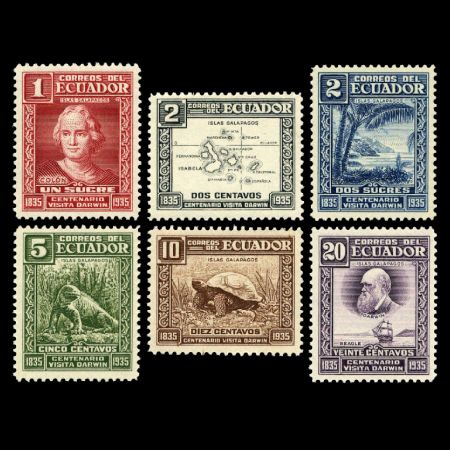
In 1936 (exact date is unknown), the Post Authority of Ecuador issued the set of 6 stamps "Centenary of the Darwin voyage to the Galapagos Islands".
The stamp with the portrait of Charles Darwin is the first stamp dedicated to the great scientist.
The islands are famed for their vast number of endemic species and were studied by Charles Darwin during the voyage of the Beagle. His observations and collections contributed to the inception of Darwin's theory of evolution by natural selection.
Later the same year, 5 of the 6 stamps were issued overprinted with "OFFICIAL" for government mail use. Only the map stamp was not overprinted.
The set of stamps was proposed by Dr. Victor Wolfgang von Hagen to raise a fund to "save the fauna of the most fascinating theater of living evolution in the world".
These stamps of von Hagen are the only stamps issued in the world to celebrate the centenary of the Darwin voyage on Galapagos Islands.
With few exceptions, the scientific community had forgotten the date. No official celebrations were organized.
Dr. Victor Wolfgang von Hagen (1908 – 1985), was an American explorer author,
archaeological historian, naturalist and anthropologist who travelled in South America with his wife.
As a naturalist he was very knowledgeable of the Galapagos Islands and wrote the first comprehensive study
of the giant tortoise.
He was also an expert on the islands' plant life.
Von Hagen was awarded the Orden de Merito by the Republic of Ecuador for his conservation work in the Galapagos.
The same year, at his meeting with Ecuadorian president Jose Maria Velasco Ibarra at the Presidential Palace in Quito Dr. von Hagen convinced him to erect a monument of Charles Darwin on San Christobal island (the first island in the Galapagos Islands that Darwin visited) for the centenary of the Darwin voyage on Galapagos Islands in the following year.
 |
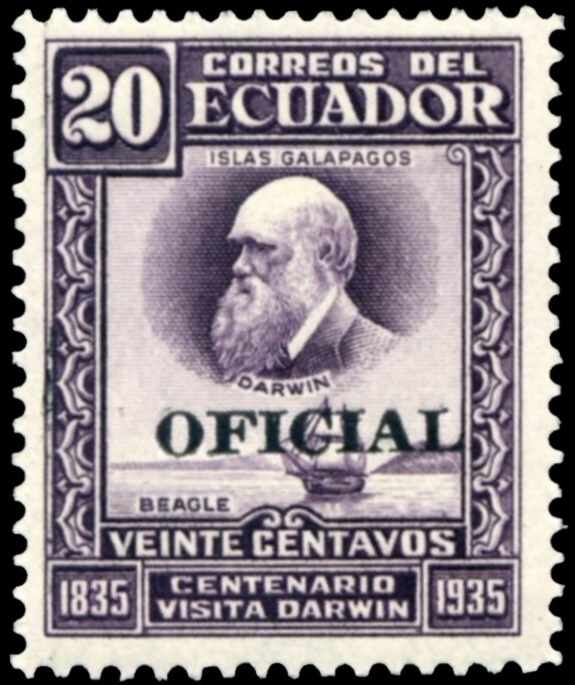 |
| The first stamp of Charles Darwin - Ecuador 1936. MiNr.: 349, Scott: 343 (overprinted stamps: MiNr.: D144, Scott: O193). | |
The money raised from the sale of the stamps was supposed to be used to build a permanent research station on Santa Cruz Island.
The president was impressed by von Hagen proposals and gave him official permission to proceed to a meeting with the Minister of Post and Transportation to discuss all the details.
In 1978 von Hagen wrote in his memoir:
"This was, unbelievably, the easiest of all my projects; the designs were given to the Quito representative of Thomas de la Rue Ltd., specialist in such stamps issues, final designs were made later in the year, approved, and the memorial stamps were actually issued."
After these meetings, Dr. von Hagen departed from Quito for an eight month expedition in the Amazon with the impression that the pedestal for the bust would be built and the stamps printed by the time he returned.
During the expedition, much happened in Ecuador. The president Jose Maria Velasco Ibarra was removed from the office, the stamps had not been printed yet, and the mason who built the pedestal had written his name in a huge font, completely dwarfing Charles Darwin’s name.
Due to these reasons, von Hagen was only able to host a simple ceremony. Only a few indigenous people were present, mainly for the wine that was to follow the ceremony.
Von Hagan gave a short speech in Spanish, then the Commandant (who knew nothing of Darwin), accepted the monument in the name of the Republic of Ecuador.
The monument was a replica of one in the American Museum of Natural History in New York City.
It was accompanied by a plaque being an inscription by Darwin’s son, Major Leonard Darwin.
The monument is still present at the original site – but the site now belongs to Ecuador’s Second Zone Naval Base and is surrounded by fencing.
The short text on the pedestal, written in English:
"CHARLES DARWIN
landed on the Galapagos Islands in 1835 and his studies of the distribution of animals and plants thereon led him for the first time to consider the problem of organic evolution.
Thus was started that revolution in thought on this subject which has since taken place.
Erected September 17th 1935 by members of the Darwin Memorial Expedition.
Victor Wolfgang von Hagen, Alexander R. Brown III, Christine Inez Brooks, Christine Inez von Hagen, Dard Huter. "
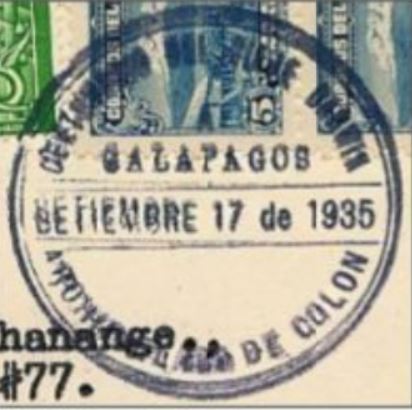 |
| Commemorative postmarks of Ecuador 1935 for opening the monument of Charles Darwin on San Christobal island of Galapagos archipelago. |
As the stamps set was not ready by the time of monument opening, this event was commemorated by a special postmark only.
This postmark was in use on the day the ceremony: September 17th 1935 only.
The text on the postmark is "Centenario del Viaje Darwin/ Galápagos/ Settembre 17 de 1935/ Archipiélago de Colón". ("Centennial of the Darwin Voyage / Galapagos / September 17, 1935 / Colon [Columbus] Archipelago").
According to "The Voyage of the Beagle" by Charles Darwin, the HMS Beagle arrived in the Galapagos Islands on 15th September 1835, but the crew including Charles Darwin landed on Chatham Island (Isla San Cristobal) on the 17th September.
Darwin study of several volcanic formations over the 5 weeks he stayed in the islands, led to several important geological discoveries, including the first, correct explanation of how volcanic tuff is formed.Darwin collected individuals of mockingbirds and finches from different islands in the Galapagos Islands. As he thought these individuals were unrelated to each other he did not bother labelling them by island.
Towards the end of the voyage, Darwin speculated that the distribution of the mockingbirds, finches and the tortoises might "undermine the stability of Species".
After returning to England, he was surprised to observe that there was more variability in the mockingbirds and finches he had collected then he had suspected initially.
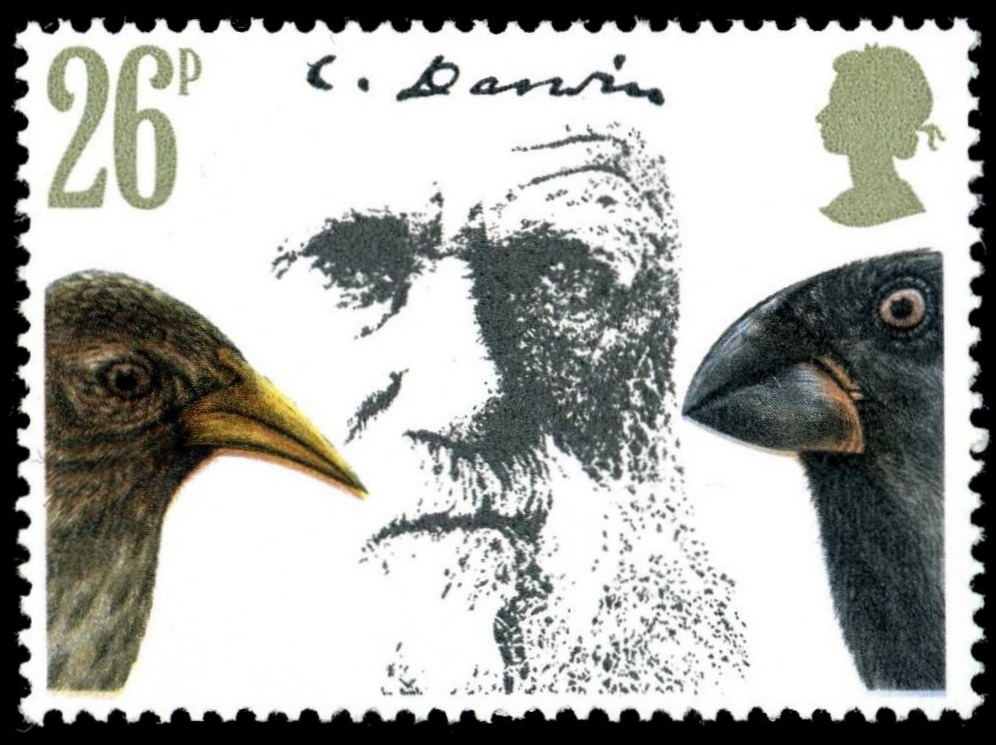 |
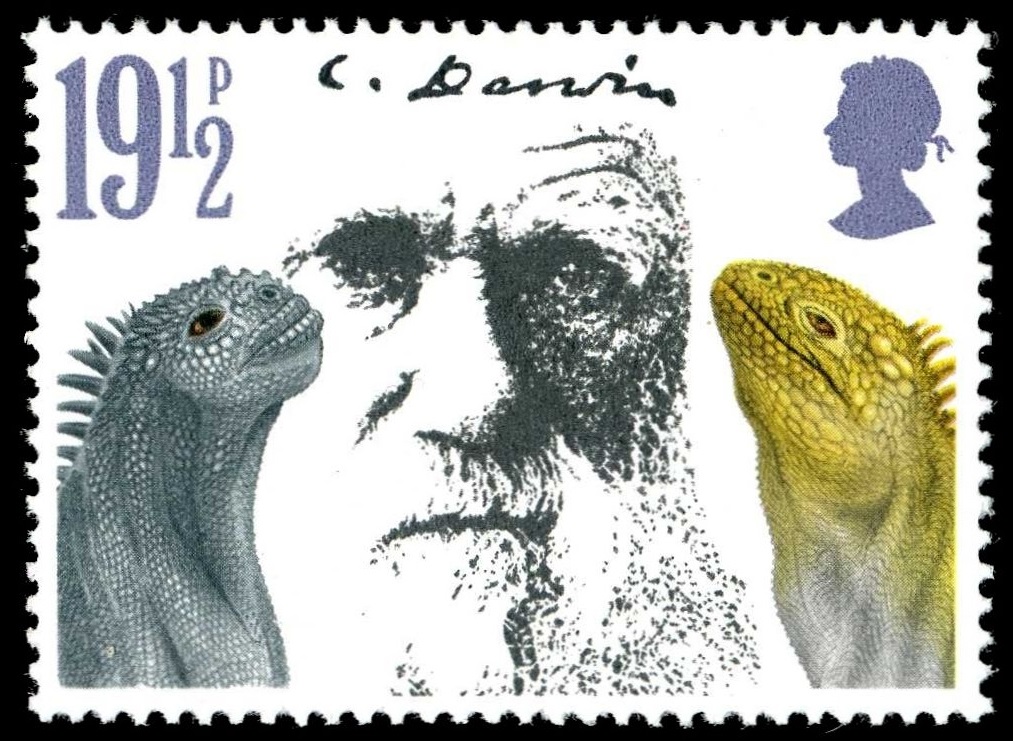 |
| Charles Darwin with two finches from the Galapagos islands on stamp of UK 1982, MiNr.: 908, Scott: 967. | Charles Darwin with two iguanas from the Galapagos islands on stamp of UK 1982, MiNr.: 907, Scott: 966. |
Another two animals observed and collected by Darwin on the islands were iguanas and tortoises.
- The dark marine iguana, feed on seaweed in the cold waters round the rocky coasts. They spend a considerable part of their day basking in the sunshine after their feeding excursions in the sea. Their broad, blunt jaws and armoured heads protect them from the sharp rocks even in rough water.
- The land iguana which feeds on cactus pads and other plants, has a tail with a round section and a narrower face with less protection.
- The dome shaped tortoises are ground feeders eating cactus pads and low growing plants.
- The saddle backed tortoises with their long necks and flared carapace stretch up and feed on bushes and taller cacti.
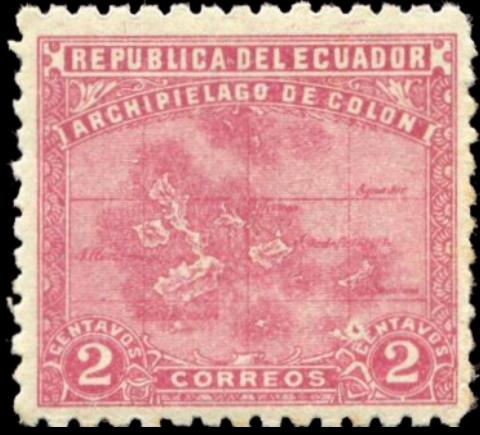 |
| Unadoopted stamp with the Galapagos Archipelago map - Ecuador 1922. |
Perhaps to raise a bit more money for the good purpose, the stamp of Christopher Columbus was included in the set.
1935 was also the year of 400th anniversary of the Galapagos archipelago discovery.
The islands were discovered by Friar Tomás de Berlanga (1487-1551), the Bishop of Panama in that time,
who named it "Insulae de los Galopegos" (Islands of the Tortoises).
The archipelago was annexed to Ecuador in 1832 and was named “Archipiélago del Ecuador”.
Its official name, however, is the Colon [Columbus] Archipelago, but it is mostly known by its Spanish name "Islas Galápagos"
or "Galapagos Islands" in English.
The map stamp was based on a design that had been prepared in 1922 for an earlier set of stamps that had not been issued.
These stamps have different colors and the face values.
| Overprinted stamps | Example of circulated covers | |
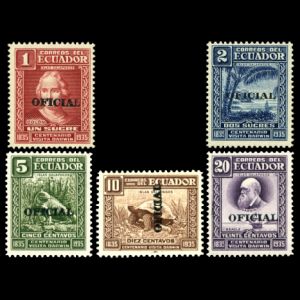 |
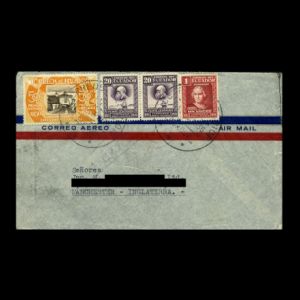 |
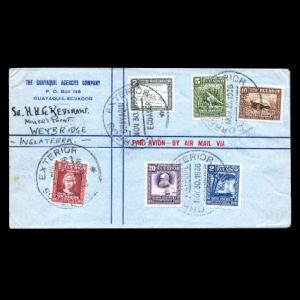 |
Some books of and about Charles Darwin
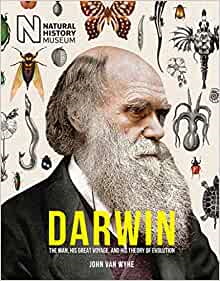
|
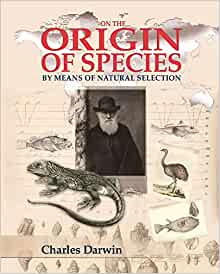
|
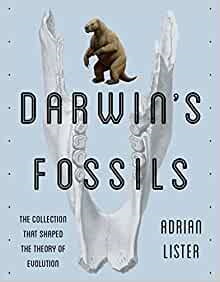
|
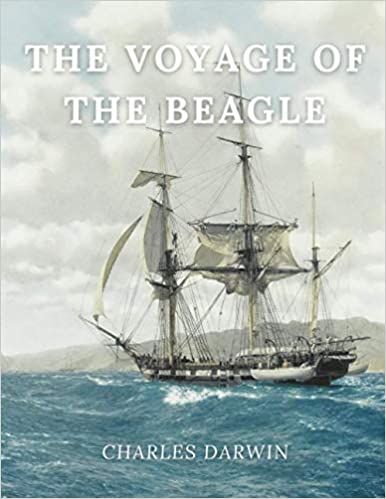
|
|
"Darwin: The Man, his great voyage, and his Theory of Evolution", by John Van Wyhe. Published in 2018. Amazon: USA, UK, DE Free PDF files from Darwin-online website: "Charles Darwin: his life and work by Charles Frederick Holder, published in 1892" |
"On the Origin of Species: By Means of Natural Selection: Slip-Cased Edition" Amazon: USA, UK, DE Free PDF files from Darwin-online website. |
"Darwin's Fossils: The Collection That Shaped the Theory of Evolution", by Adrian Lister. Published in 2018. Amazon: USA, UK, DE |
"The Voyage of the Beagle" Amazon: USA, UK, DE Free PDF files from Darwin-online website. |
References
- [R1] Technical Details: Colnect, http://www.girafamania.com.br (not exist anymore).
- [R2] The history of these stamps:
"Galápagos: An Encyclopedia of Geography, History, and Culture" By Randy Moore, printed in 2021, ISBN: 978-1440864698, ( page 348)
"Charles Darwin Slept Here" by John Woram, published in 2005, ISBN: 978-0976933601 (pages 273-278).
- [R3] Victor Wolfgang von Hagen: Wikipedia.
- [R4] Galápagos Islands: Wikipedia.
- [R5] Charles Darwin voyage to the Galapagos Islands: "THE VOYAGE OF THE BEAGLE" , by Charles Darwin, CHAPTER XVII — GALAPAGOS ARCHIPELAGO

|
Acknowledgements
- Many thanks to Dr. Peter Voice from Department of Geological and Environmental Sciences, Western Michigan University, for reviewing the draft page and his very valuable comments.
- Many thanks to fellow collector Peter Brandhuber from Germany (who runs the Evolution of mankind and Philately group on facebook) for his help finding information for this article.
| <prev | back to index | next> |